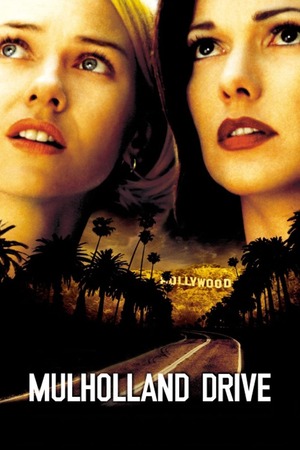
Director: David Lynch
Starring: Naomi Watts, Laura Harring, Justin Theroux, Ann Miller
🌀 Introduction: A Puzzle Without Edges
David Lynch’s Mulholland Drive (2001) has long been regarded as a cinematic enigma — a dream, a nightmare, or perhaps both. Its nonlinear structure, cryptic symbols, and dual identities create a cinematic experience that defies easy explanation. This film is not meant to be solved like a riddle, but interpreted through emotion, suggestion, and dream logic.
This post unpacks the film’s major themes and symbols: dreams and reality, fractured identity, desire and repression, and the underbelly of Hollywood. Rather than offering a “single truth,” it explores how the film’s form reflects the emotional disintegration of its protagonist — and by extension, the myth of self-constructed identity.
🌙 Dream vs. Reality
The most common interpretation of Mulholland Drive sees the film’s first two-thirds as a dream or fantasy constructed by the character Diane Selwyn (Naomi Watts), who reimagines herself as Betty Elms, a fresh-faced actress arriving in Hollywood. In this fantasy, Betty is optimistic, talented, loved, and heroic — a stark contrast to the final third of the film, where Diane is bitter, jaded, and consumed by guilt and jealousy.
Through this lens, the film's surreal structure reflects the collapse of a fragile psyche. The transition from dream to reality — marked by the opening of the mysterious blue box — is Lynch's metaphor for waking up from denial. In that shift, the world goes from golden possibility to somber reality. Time warps, characters shift, and identities collapse.
🎭 Dual Identities and Fragmented Selves
The duality between Betty/Diane and Rita/Camilla represents fractured identities. Betty is everything Diane wishes she were — successful, confident, morally righteous — while Rita is the idealized version of Camilla, her lover who left her. Their relationship in the dream world is tender and innocent, a stark contrast to the manipulative and transactional relationship in reality.
This fragmentation is central to the film’s identity crisis. Lynch isn’t merely telling a story; he’s exploring how the self disintegrates under trauma, jealousy, and failure. In Lynchian logic, people don’t just break down emotionally — they split, morph, and become unrecognizable to themselves.
🎬 Hollywood as a Machine of Illusion
Mulholland Drive doubles as a commentary on Hollywood itself — a place where dreams are manufactured, sold, and shattered. The casting couch politics, power dynamics, and manufactured personas reflect how the industry consumes human identity. The studio executive who declares “This is the girl” strips directors of autonomy — just as Diane is stripped of agency in her own life.
The film reveals Hollywood not as a city, but as a state of mind — a machine that produces fantasy at the cost of reality. Diane’s dream of success and love turns into a living nightmare when the illusion can no longer be maintained.
🪄 The Blue Box, the Winkie’s Man, and the Silencio Club
Lynch loads the film with symbols that defy literal explanation but are emotionally resonant:
- The Blue Box: Unlocks the truth and collapses the dream. It symbolizes the mind cracking open under pressure, revealing what was suppressed.
- The Winkie’s Bum: A grotesque figure representing shame, fear, and guilt. It's Diane’s subconscious terror made flesh — the monster behind the illusion.
- Club Silencio: A meta-commentary on illusion and performance. “There is no band,” yet the music still plays. It's a wake-up call: everything the viewer — and Diane — has believed is fabrication.
Lynch doesn’t provide answers — he shows truths in abstract. These moments function more like emotional landmines than narrative breadcrumbs. They’re meant to be felt, not solved.
💔 Desire, Repression, and Guilt
At its heart, Mulholland Drive is about unrequited love and emotional repression. Diane’s love for Camilla is intense, but also riddled with jealousy, inferiority, and rage. When Camilla leaves her, not only for a man but for greater success, Diane’s fantasy unravels. She can’t bear the pain, and in an act of ultimate self-betrayal, she hires someone to kill Camilla.
The film’s dream logic allows Diane to live out an alternate reality — one where she is loved, heroic, and victorious. But reality reasserts itself through symbols, fragments, and the inevitable opening of the blue box. Guilt is inescapable, and Diane’s ultimate fate — suicide — is not a punishment, but a tragic surrender to inner collapse.
🧠 Lynchian Structure & Sound
Lynch eschews traditional storytelling. He structures the film like a dream — nonlinear, repetitive, symbolic. Dialogue stumbles, scenes fade into one another without causality. Sound design is used not to support visuals but to disorient. A low hum underpins scenes of apparent calm, creating a sense of dread even before we know why.
The film’s chronology doesn’t follow time but emotion. That’s what makes Mulholland Drive so disorienting yet hypnotic: it mimics the way dreams collapse under memory, guilt, and longing.
🎯 Final Thoughts
Mulholland Drive is not meant to be fully understood. It’s an emotional landscape, not a plot puzzle. Its themes of fractured identity, suppressed desire, and the destructive pursuit of fantasy are universal, even as the story resists clarity. David Lynch invites you to feel your way through the film, trusting your emotions more than logic.
Like the blue box, the film opens to reveal something personal — not a tidy solution, but a mirror of our own fears, desires, and need to dream even when it destroys us.